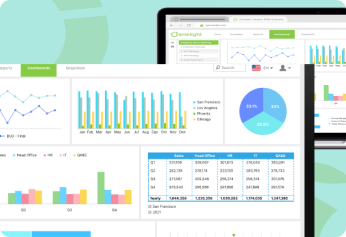Understanding forecasting terminology is crucial for finance professionals, business leaders, and analysts who rely on data-driven predictions to make informed decisions. This glossary breaks down essential forecasting concepts, from basic definitions to advanced methodologies, helping you navigate the complex world of predictive analytics with confidence.
Whether you're building budget models, planning workforce needs, or analyzing market trends, having a solid grasp of forecasting fundamentals will improve your ability to anticipate future outcomes and respond strategically to changing conditions.
What is Forecasting?
Forecasting is the process of making informed predictions about future events, trends, or outcomes based on historical data, current conditions, and analytical models. Rather than guessing what might happen, forecasting uses systematic approaches to estimate probable scenarios.
The primary purpose of forecasting is to reduce uncertainty in decision-making. When finance teams can reasonably predict revenue patterns, expense trends, or cash flow requirements, they can allocate resources more effectively and identify potential challenges before they become critical problems.
Forecasting plays a vital role across industries – from predicting customer demand in retail to estimating patient volumes in healthcare. The accuracy of these predictions directly impacts operational efficiency, financial performance, and strategic planning success.
Types of Forecasting
Forecasting methods fall into two main categories, each suited to different situations and data availability. Understanding when to use each type helps ensure you select the most appropriate approach for your specific needs.
1. Qualitative Forecasting Methods
Qualitative forecasting relies on expert judgment, opinions, and subjective analysis rather than numerical data alone. These methods prove especially valuable when historical data is limited or when predicting entirely new market conditions.
- Expert Judgment involves consulting with industry specialists or experienced professionals who can provide insights based on their knowledge and intuition. For instance, a seasoned sales manager might predict quarterly performance based on customer conversations and market observations.
- Market Research gathers information directly from customers, suppliers, or industry participants through surveys, interviews, or focus groups. This approach works well for understanding consumer preferences or testing new product concepts.
- Delphi Method structures expert opinion gathering by having multiple specialists provide anonymous forecasts, then sharing summarized results for additional rounds of input. This process continues until consensus emerges, reducing individual bias while leveraging collective expertise.
Qualitative methods work best when launching new products, entering unfamiliar markets, or dealing with situations where past performance may not indicate future results.
2. Quantitative Forecasting Methods
Quantitative forecasting uses mathematical models and statistical techniques to analyze numerical data and identify patterns that can be projected forward. These methods require sufficient historical data to produce reliable results.
- Time Series Analysis examines data points collected over regular intervals to identify trends, seasonal patterns, and cyclical behaviors. Monthly sales figures or quarterly revenue data provide good examples of time series that can be analyzed for forecasting purposes.
- Regression Analysis identifies relationships between different variables to predict how changes in one factor might affect another. A company might use regression to understand how marketing spend correlates with lead generation or how economic indicators influence customer purchasing behavior.
- Econometric Models combine economic theory with statistical methods to forecast complex business scenarios. These sophisticated approaches can incorporate multiple variables and their interactions to predict outcomes like market demand or pricing dynamics.
Quantitative methods excel when you have clean, consistent historical data and when underlying relationships remain relatively stable over time.
Forecasting Process
Effective forecasting follows a structured approach that ensures accuracy and reliability. This systematic process helps identify the best methods for your situation while minimizing common pitfalls.
Step 1: Define the forecasting objective clearly. Determine what you need to predict, the time horizon involved, and how the forecast will be used. A cash flow prediction for the next quarter requires different approaches than a five-year strategic plan.
Step 2: Gather and prepare relevant data. Collect historical information, clean inconsistencies, and organize the data in a format suitable for analysis. Poor data quality undermines even the most sophisticated forecasting methods.
Step 3: Select appropriate forecasting methods based on your data characteristics, time horizon, and accuracy requirements. Consider trying multiple approaches to compare results and identify the most reliable option.
Step 4: Develop and test your forecast model using historical data. Apply your chosen method to past periods where you know the actual outcomes, then measure how accurately the model would have predicted those results.
Step 5: Generate the forecast and document your assumptions. Create predictions for your target period while clearly noting any limitations or conditions that might affect accuracy.
Step 6: Monitor performance and refine the model. Compare actual results to your predictions, identify sources of error, and adjust your approach for future forecasting cycles.
This process repeats regularly, with each cycle providing opportunities to improve accuracy and adapt to changing conditions.
Accuracy and Evaluation
Measuring forecast accuracy helps you understand how well your predictions perform and identify areas for improvement. Several metrics provide different perspectives on forecasting effectiveness.
- Mean Absolute Error (MAE) calculates the average difference between predicted and actual values, ignoring whether the error was positive or negative. This metric gives you a straightforward sense of typical prediction accuracy in the same units as your original data.
- Root Mean Square Error (RMSE) penalizes larger errors more heavily than smaller ones, making it useful when big mistakes are particularly costly. RMSE values are expressed in the same units as your data, making them easy to interpret.
- Mean Absolute Percentage Error (MAPE) expresses accuracy as a percentage, which helps compare forecasting performance across different scales or time periods. A 5% MAPE means your predictions typically fall within 5% of actual results.
|
Metric |
Best Used When |
Key Advantage |
Limitation |
|
MAE |
You want simple, interpretable accuracy |
Easy to understand |
Doesn't penalize large errors |
|
RMSE |
Large errors are costly |
Emphasizes bigger mistakes |
More complex calculation |
|
MAPE |
Comparing across different scales |
Percentage-based comparison |
Problems with zero values |
Regular evaluation helps you track whether your forecasting accuracy improves over time and alerts you when model performance starts declining due to changing conditions.
Applications of Forecasting
Forecasting supports decision-making across virtually every industry and business function. Understanding these applications helps you recognize opportunities to improve your own planning processes.
- Financial Planning uses forecasting to predict revenue, expenses, cash flow, and capital requirements. Finance teams rely on these predictions to create budgets, secure funding, and optimize resource allocation. Accurate financial forecasts enable proactive management rather than reactive responses to funding shortfalls or unexpected expenses.
- Supply Chain Management depends on demand forecasting to determine inventory levels, production schedules, and distribution requirements. Retailers use sales forecasts to stock appropriate merchandise, while manufacturers predict component needs to avoid production delays.
- Healthcare Planning employs forecasting to anticipate patient volumes, staffing requirements, and resource utilization. Hospitals might predict seasonal illness patterns or emergency room traffic to ensure adequate staffing and supplies.
- Weather Prediction combines atmospheric data with complex models to forecast conditions days or weeks in advance. These predictions support everything from agricultural planning to airline scheduling and emergency preparedness.
- Human Resources uses workforce forecasting to predict hiring needs, training requirements, and succession planning. Organizations can anticipate skill gaps and plan recruitment or development programs accordingly.
Each application requires tailored approaches based on the specific data available, prediction timeframes, and decision-making requirements involved.
Limitations of Forecasting
Even the most sophisticated forecasting methods face inherent limitations that can affect accuracy and reliability. Recognizing these constraints helps set realistic expectations and develop contingency plans.
- Data Quality Issues represent one of the most common challenges. Incomplete records, measurement errors, or inconsistent data collection methods can undermine even excellent forecasting techniques. Historical data may not reflect current conditions if business processes, market dynamics, or competitive landscapes have changed significantly.
- Model Assumptions create another source of potential error. Every forecasting method makes assumptions about relationships between variables, the stability of patterns, or the absence of external disruptions. When these assumptions prove incorrect, forecast accuracy suffers accordingly.
- Unforeseen Events can completely invalidate predictions based on historical patterns. Economic crises, natural disasters, regulatory changes, or technological disruptions can create entirely new conditions that historical data cannot anticipate.
- Time Horizon Effects mean that forecast accuracy typically decreases as prediction periods extend further into the future. Short-term forecasts generally prove more reliable than long-term projections due to the accumulating impact of uncertainty over time.
To mitigate these limitations, consider using multiple forecasting methods, regularly updating models with new data, incorporating expert judgment alongside statistical analysis, and developing scenario plans for different possible outcomes.
Tips for Effective Forecasting
Improving forecasting accuracy requires attention to both technical methods and practical implementation considerations. These strategies help you get better results from your prediction efforts.
- Use Multiple Models rather than relying on a single approach. Compare results from different methods to identify consensus predictions and understand the range of possible outcomes. When multiple techniques produce similar forecasts, you can have greater confidence in the results.
- Stay Current with Data by updating your models regularly as new information becomes available. Forecasting accuracy often deteriorates over time as conditions change, so refresh your analysis frequently rather than using outdated models.
- Incorporate Expert Opinion even when using quantitative methods. Subject matter experts can provide context about unusual circumstances, market shifts, or operational changes that might not be apparent in historical data alone.
- Document Your Process including assumptions, data sources, and methodology choices. This documentation helps others understand your approach and enables you to refine methods based on performance feedback.
- Test Different Time Horizons to understand how your accuracy changes with prediction distance. Some methods work well for short-term forecasts but become unreliable for longer periods, while others maintain consistency across different timeframes.
- Consider Seasonal Patterns and cyclical behaviors that might affect your predictions. Business cycles, seasonal demand variations, or recurring events can significantly impact forecast accuracy if not properly incorporated into your models.
- Plan for Uncertainty by creating multiple scenarios rather than single-point predictions. Best-case, worst-case, and most-likely scenarios help stakeholders understand the range of possible outcomes and prepare appropriate responses.
Streamline Your Forecasting with Modern FP&A Solutions
While understanding forecasting fundamentals is essential, implementing them effectively often requires moving beyond time-consuming spreadsheets that introduce errors. Modern financial planning platforms can transform your team’s approach by providing integrated data sources, pre-built templates, and automated analysis tools.
Limelight offers an intuitive, no-code platform that connects directly to your ERP and accounting systems, eliminating data consolidation challenges. With built-in forecasting templates and real-time dashboards, your team can focus on insights and strategy rather than manual data work.
Book a demo to see how Limelight can accelerate your forecasting and help your team move from spreadsheet-based predictions to reliable, scalable solutions.
Table of Contents
Ready to put an end to outdated FP&A?
Get a perzonalized demo


